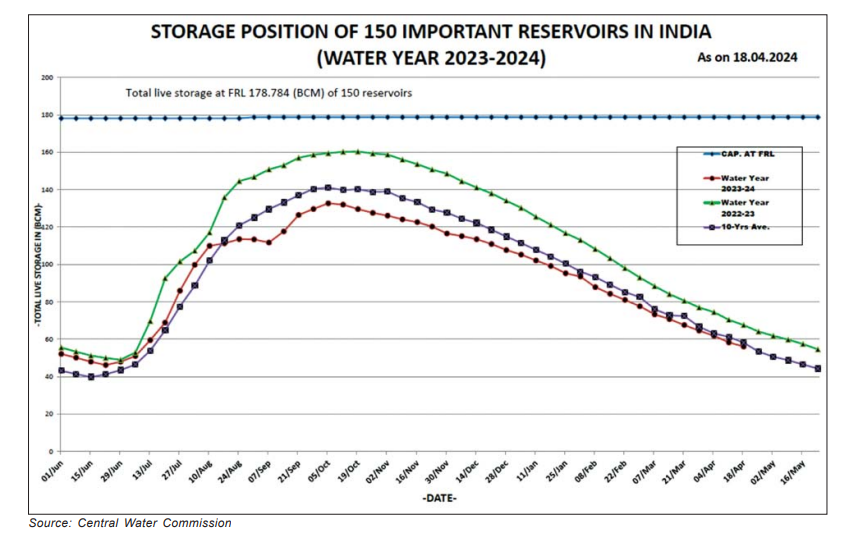Multiple meteorological organizations are anticipating that the southwest monsoon will bring abundant rainfall to the Indian subcontinent this year. The India Meteorological Department (IMD) expects above-normal rainfall during this year’s southwest monsoon season due to the expected development of La Nina conditions in the latter part of the season. According to the weather bureau’s announcement, the total rainfall from June to September is anticipated to be 106% of the long-period average, with a margin of error of plus or minus 5%. In the meantime, private weather forecaster Skymet Weather Services has projected monsoon rainfall to be normal at 102% of the long period average this year and the APEC Climate Centre too has echoed a similar forecast of above normal rainfall for India during the South-West monsoon spanning from June-September.
The southwest monsoons last year had ended with a 6 percent deficit of the long period average predominantly due to El Nino and was characterized by wide spatial and temporal variations. Those regions that generally get good rains have received less rain this season, while dry regions like West Rajasthan and Saurashtra-Kutch received bountiful. The distribution of rainfall too showed considerable discrepancies. According to the IMD, out of the total 36 meteorological subdivisions, 3 subdivisions constituting 9% of the total area of the country received excess, 26 subdivisions received normal rainfall (73% of the total area) and 7 subdivisions (18% of the total area) received deficient rainfall. The 7 Met subdivisions that got deficient rainfall are Nagaland, Manipur, Mizoram, and Tripura (NMMT), Gangetic West Bengal, Jharkhand, Bihar, East UP, South interior Karnataka, and Kerala.
The forecast of normal monsoon rains this year has come as a relief at a time when agriculture output is seen declining, food inflation staying sticky, dipping buffer stocks, and dwindling water levels in reservoirs. Delayed start, uneven distribution and intensity during the monsoons last year impacted agriculture output as about 50 percent of the net cultivated area is monsoon-dependent and rainfed agriculture contributes to around 40 percent of the country’s total food production. The Second Advance Estimates of the National Income 2023-24 released by the National Statistical Office (NSO), Ministry of Statistics and Programme Implementation (MoSPI) points out that the gross value added (GVA) in the agriculture and allied sector is expected to expand only by 0.7 percent compared to 4.7 percent growth achieved in the FY 2022-23. This would be the slowest growth in eight years and lower than the 1.8% growth projected in the first advance estimate. Slow growth is mainly attributed to the decline seen in farm output. Food grain production in India is set to decline by six per cent in 2023-24. According to the second advance estimates released by the Ministry of Agriculture and Farmers’ Welfare, Government of India, for the crop year 2023-24 (July-June), food grain production in the country is estimated to be 309 million tonnes compared to 329.6 million tonnes produced in 2022-23, and against the target of 332 million tonnes. The kharif food grains production is seen at 1541.87 lakh tonnes, while rabi output is estimated to be 1551.61 lakh tonnes, down by 15 and 26 lakh tonnes respectively in 2023-24 compared to last year.
| Second Advance Estimates of Production of Oilseeds & Commercial Crops for 2023-24 (Production in Lakh Tonnes) | ||||
| Crop | Season | 2022-23 | 2023-24* | YoY Chg (%) |
| Rice | Kharif | 1105.12 | 1114.58 | 0.86 |
| Rabi | 150.04 | 123.57 | -17.64 | |
| Summer | 102.4 | — | ||
| Total | 1357.55 | 1238.15 | -8.80 | |
| Wheat | Rabi | 1105.54 | 1120.19 | 1.33 |
| Cereals | Kharif | 1480.9 | 1470.69 | -0.69 |
| Rabi | 1414.82 | 1388.37 | -1.87 | |
| Summer | 140.56 | — | ||
| Total | 3036.28 | 2859.07 | -5.84 | |
| Pulses | Kharif | 76.21 | 71.18 | -6.60 |
| Rabi | 163.58 | 163.24 | -0.21 | |
| Summer | 20.79 | — | ||
| Total | 260.58 | 234.42 | -10.04 | |
| Total Food Grains | Kharif | 1557.11 | 1541.87 | -0.98 |
| Rabi | 1578.41 | 1551.61 | -1.70 | |
| Summer | 161.35 | — | ||
| Total | 3296.87 | 3093.49 | -6.17 | |
| Total Oil Seeds | Kharif | 261.5 | 228.42 | -12.65 |
| Rabi | 141.51 | 137.56 | -2.79 | |
| Summer | 10.54 | — | ||
| Total | 413.55 | 365.99 | -11.50 | |
| Sugarcane | Kharif | 4905.33 | 4464.30 | -8.99 |
| Cotton # | Kharif | 336.6 | 323.11 | -4.01 |
| Jute & Mesta ## | Kharif | 93.92 | 96.33 | 2.57 |
# Cotton Production in Lakh Bales, 1Bale=170 Kg
## Jute & Mesta Production in Lakh Bales, 1Bale=180 Kg
*Crop production estimates covers only Kharif and Rabi season. Summer season is not included in Second AE 2023-24.
(Source: Ministry of Agriculture & Farmers Welfare)
Production of wheat is seen rising by about 15 lakh tonnes on yoy basis to 1120.19 lakh tonnes, while that of rice is seen declining 1238.15 lakh tonnes compared to 1357.55 lakh tonnes produced in the 2022-23 crop season. The decline is mainly due to shortfall in rabi rice production. However, estimates of summer crop are not included in the estimates. Cereals and pulses production is also projected to fall by 5.84 and 10.04 per cent respectively to 2859.07 lakh tonnes and 234.42 lakh tonnes respectively. Oilseed production is too declining by 11.50 per cent to 365.99 lakh tonnes compared to 413.55 lakh tonnes produced in 2022-23 crop year. Horticulture output is also expected to decline, for the first time in nine years, in 2023-24 to 355.2 million tonnes, slightly below the record output of 355.5 million tonnes achieved in 2022-23.
The deficient monsoons last year and warmer and drier weather due to El Nino have also left a considerable impact on the water level in the reservoirs in the country. The status is grim especially in the southern peninsula where the rains are deficient or largely deficient as per the data from the IMD from March 1 to April 20. Currently, as per reservoir storage bulletin dated 18.04.2024 by the Central Water Commission, live storage available 150 key reservoirs were at 56.085 BCM, which is 31% of total live storage capacity of these reservoirs compared to 67.575 BCM available in these reservoirs for the corresponding period was 67.575 BCM and the average of last 10 years live storage was 58.166 BCM.

The historically low rainfall in August last year saw the total live storage on the key 150 important reservoirs going down below the 10-year average. According to the data from the Central Water Commission at the end of August 2023, live storage available in the major 150 reservoirs was 113.417 BCM, which is 63% of total live storage capacity of these reservoirs. In the previous year the live storage available in these reservoirs for the corresponding period was 146.828 BCM and the average of last 10 years live storage was 125.117 BCM. And since then, water level in these reservoirs stayed below the 10-years live storage. With the summer to peak, the situation has worsened especially in the south of India, increasing the threat of draught. Apart from affecting the standing rabi and summer crops as well as agriculture productivity, dwindling water level could impact other sectors as well.
The prediction of normal monsoons this year have bought cheers, as it could boost the production of kharif crops such as rice, soybean, sugarcane, pulses etc, cool down food inflationary pressures, replenish water resources. Yet, the arrival, distribution, intensity, and departure of monsoon holds the key, impacting the agriculture production and productivity. Skymet expects good rainfall in the southern, western and northwestern parts of the country this year with the core monsoon rainfed zone of Maharashtra and Madhya Pradesh expected to receive adequate rainfall. The organisation adds that the eastern states of Bihar, Jharkhand, Odisha and West Bengal will be at risk of deficit rainfall during peak monsoon months of July and August, while rainfall will be below normal in the northeastern parts during the first half of the monsoon season. This may not bode well for kharif crops in these regions as these are highly dependent on rainfall in the initial phase of sowing in June and July. Heavy showers during the latter half of the monsoon season may also damage standing crops across the country.






